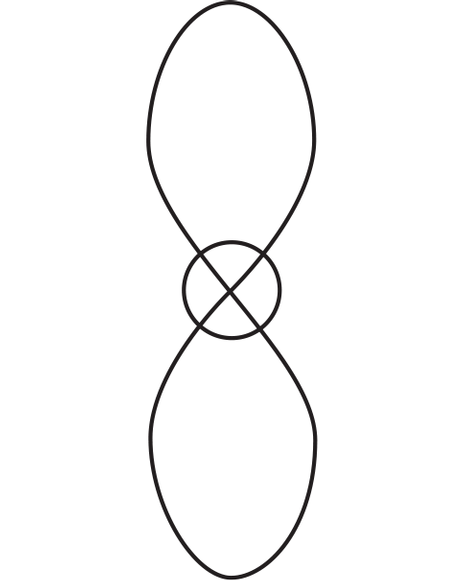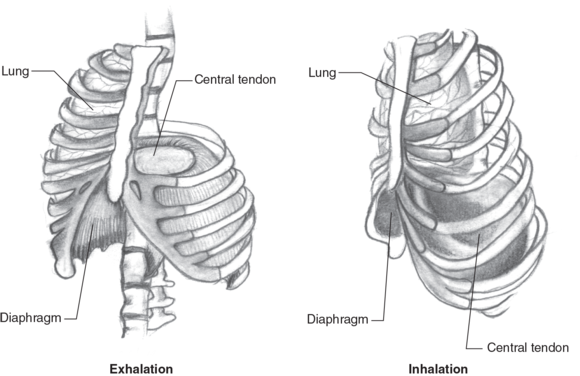Total Body Connectivity–Breath Patterning
This is an excerpt from Laban/Bartenieff Movement Studies by Colleen Wahl.
As the first Pattern of Total Body Connectivity, breath (see figure 3.1) is the baseline from which all other movement patterns develop. It is fundamental to life and among our first experiences upon entering the world. Before an infant's first breaths, the fetus practices the movements of breathing in utero, as the mother breathes for the fetus by sending oxygen through the umbilical cord.

Figure 3.1 Breath symbol.
For an infant, breath affords sensation of the inside of the body, including the body's inner volume. Through breathing you feel the internal body growing and shrinking through the swelling of the inhalation and the contracting of the exhalation. The gentle expansion and contraction of the breath's rhythm provides the basic material of human life, oxygen, and the important release of carbon dioxide.
Breath patterning assists the coordination of the internal body that is vital in human movement. Functionally, every inhalation and exhalation is a complex event. Upon inhaling, the five lobes of the lungs expand to engulf the heart and welcome oxygen. The diaphragm is pulled downward toward the pelvis by the central tendon, filling up like an inverted hot-air balloon (see figure 3.2). Oxygen is taken into the body via the lungs, where it is transferred through small air sacs called alveoli into the blood, which is pumped throughout the body by the heart—a process that allows every cell in the body to respire. Carbon dioxide is released via exhalation, eliminating waste products. As you exhale, the central tendon releases, the diaphragm contracts upward, and the pelvic floor moves up, back, and in. Deliberately bringing your awareness to your breath as support for your movement is a precursor to whole-body coordination and virtuosity in movement. This is true for movers of all levels as breath allows the entire body to be supported from within in complex coordination.

Figure 3.2 Lungs, diaphragm, and central tendon, at the height of exhalation and inhalation
Illustrated by Sydney P. Celio.
As long as there is life, breath is present; it is the baseline of life force, the river on which all movement and expression runs. As an adult, revisiting the breath pattern is a useful way of connecting with sensation. Tuning into sensation within the body offers a way of becoming present within yourself and identifying what is needed in the moment. As a way of checking in with yourself, you can revisit the breath pattern when you are overstimulated, exhausted, or stressed; observing your breath can sooth what feels overwhelming. You may notice your breath changing with your emotional states. Agitation may shorten or truncate the breath, and rest may deepen it. You can alter and shift "emotional tone" by inviting the breath. The breath pattern is a reminder that you have the choice to affect your feelings and thereby your responses. Paying attention to the sensation of breath with its wave-like, rolling inhalations and exhalations can release muscle tension associated with stress.
Notice how the breath pulses inside of your body. Sensing the breath may bring you home to yourself. Many spiritual and centering practices, like meditation and stress reduction, use a focus on the breath as a key principle because it brings centeredness. It is a way of returning to a fundamental aspect of being alive. When stressed or feeling distanced from yourself, connecting to the breath can help you reconnect to yourself and feel calmer and more present.
Breath also provides access to the sense of yielding, bonding, and being with that will be discussed in depth later in this chapter. Imagine that as you attend to your breath you can soften the surfaces of your body and bond with the surfaces of support around you.
Breath brings with it a sense of the connection between one's inner and outer worlds, an experience that can be life-giving and profoundly essential. The exchange of oxygen and carbon dioxide changes the torso as it expands and contracts. Allow this internal to growing and shrinking to support and fill your movement. Breath support is a concept used by Irmgard Bartenieff to illustrate the breath's ability to support and enliven full-bodied movement.
Visiting the breath pattern can provide another way of getting ready for activity. Breath supports movement. To accompany and support movement, the breath can be activated and vigorous, or soft, sustained, and elongated. Beginning an activity by getting the breath going is like preparing the insides of the body for what will later become activated outwardly. By using breath as part of a warm-up, you activate sensations of the internal three-dimensional support for movement, and you recruit the tissues of the body to be responsive and pliable.
For many adults who lead sedentary lives, the torso can feel tense and stuck, while their attention is directed outward. Attending to the flow of breath by directing attention inward can help them find movement and ease in the torso. When tension headaches or fatigue arises due to limited and contained movement, a person can deliberately deepen the flow of breath to nourish tissue and find new movement potential throughout the torso. To help you visualize the flow of breath, imagine a surfer riding a wave into shore. Like the wave that catches the surfboard, "catch" your exhalation and "ride" its undulating pattern through your body, noticing how and where it moves. You can also explore the feeling of being filled and expanded by the inhalation.
Bringing breath patterning into the forefront of your movement gives you the opportunity to let breath guide and initiate and influence the movement. In this way, the breath stimulates support of the core, the supple undulations of the spine, and massages the connection between upper and lower body. Fully receiving the exhalation allows for the area around the belly button to gather and hollow inward toward the organs, providing the first inklings of what will come next in movement.
As an expression of inner life, breath patterning has an audible nature, revealed in sounding and speaking. Every verbal or sounded expression rides on the breath; we can either use it fully or diminish and stunt it. An example of breath support in sound is the grandeur of passionate song or chanted liturgy; an example in which breath struggles to support us is hyperventilation. As the expression of inner life, another person's use of breath allows us to perceive the states of his or her thoughts and feelings. Listening to someone talk and sensing the congruence between breath, voice, and body gives the sense that they are coming from a grounded, centered, and committed place. We sense them as believable.
Finally, breath patterning supports big, exuberant, and virtuosic movement. It increases the strength of a boxer's punch or the quick burst of a swimmer's takeoff. The horseback rider uses her breathing to control and communicate to the horse, and the dancer exhales as he prepares to turn.
Explore the Breath Pattern
Check in with your breath. No need to boss it around. Bring your attention to what is currently happening with your breath, and allow it to change as it will. Notice the movement your breath is inspiring in your body. Can you send breath to areas that feel tight or bound up to change the tension of your tissues? Follow and ride the breath pathway like you might follow and ride a wave. Notice where in your body the organs and tissue grow with your breath, and where your internal world is softening or shrinking. Take some time here, and notice how you feel and what this experience has brought. Try singing or sounding the song of your breath. Have your feelings shifted? Where might actively focusing on your breath patterning be useful for you? How might your awareness serve you in your daily life?
Key Points for the Breath Pattern
- Connecting to breath is a way of connecting to and centering the self.
- Breath brings oxygen to the blood and tissues, and releases carbon dioxide waste.
- Breath is the infant's first experience of the inner volume of the body.
- The end of the exhalation, when the breath empties and the diaphragm floats upward, sets up the core-softening necessary for the next pattern.
- Breath support enlivens movement throughout the whole body and promotes complexity and virtuosity in movement.
SHOP

Get the latest insights with regular newsletters, plus periodic product information and special insider offers.
JOIN NOW


